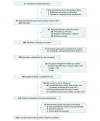Association of Participation in an End-of-Life Conversation Game With Advance Care Planning Behavior and Perspectives Among African American Individuals
- PMID: 32383747
- PMCID: PMC7210487
- DOI: 10.1001/jamanetworkopen.2020.4315
Association of Participation in an End-of-Life Conversation Game With Advance Care Planning Behavior and Perspectives Among African American Individuals
Abstract
Importance: Less than 25% of African American individuals have completed advance directives and are thus vulnerable to poor end-of-life care. Low-cost interventions are needed to increase engagement in advance care planning (ACP).
Objectives: To investigate whether an end-of-life conversation game motivates African American attendees to engage in ACP and to assess whether the game is well received and endorsed.
Exposures: Attendance at an end-of-life conversation game (Hello) played in groups of 4 to 6 participants for 60 minutes.
Design, setting, and participants: Prospective, mixed-methods cohort study conducted from 2018 to 2019 with a 3- to 11-month follow-up interview. Game events were held in 53 community venues across the US; 15 were purposively sampled for onsite research procedures. Of 428 attendees at purposively sampled sites, 386 (90%) consented to research procedures (6 attendees were removed from analysis for protocol deviation). Of 367 attendees who provided accurate contact information, 232 (63%) were contacted, and 220 were included in follow-up analyses.
Main outcomes and measures: The primary outcome was advance directive completion rates after the intervention. Secondary outcomes included rates of other ACP behaviors, ACP engagement, conversation satisfaction and realism, and participants' Net Promoter Score (a measure of endorsement). Follow-up telephone interviews explored the game experience and relevant ACP behaviors of attendees.
Results: Of 380 individuals who participated (mean [SD] age, 62.2 [13.8] years; 304 were female [80%], and 348 were [92%] African American), none withdrew because of an adverse event. After the intervention, 91 of 220 attendees (41%) completed a new advance directive; 176 of 220 attendees (80%) discussed end-of-life wishes with loved ones, and 214 of 219 attendees (98%) completed at least 1 ACP behavior. There was a moderate increase in the self-efficacy domain on the ACP Engagement Survey (mean [SD] change from before to after the game, 0.54 [0.98]; P < .001). The mean (SD) conversation satisfaction score was 6.21 (0.93) (range, 1-7, with 7 being highest satisfaction), and the overall Net Promoter Score was 57.89 (range, -100 to 100, with 100 being highest endorsement). Interviews revealed 5 themes about the game: (1) it was a useful forum for ACP; (2) it provided new information and perspective; (3) it was emotionally beneficial; (4) it increased appreciation for ACP; and (5) it empowered and motivated participants to perform ACP. Mixed-methods integration showed convergence across data sets.
Conclusions and relevance: Among a nationwide sample of African American individuals, the end-of-life conversation game appeared to be well received and was associated with high rates of ACP behavior. This low-cost and scalable tool may help reduce health disparities associated with end-of-life care.
Conflict of interest statement
Figures
References
-
- Dying in America Improving Quality and Honoring Individual Preferences Near the End of Life. The Institute of Medicine; 2014.
Publication types
MeSH terms
Grants and funding
LinkOut - more resources
Full Text Sources
Medical


